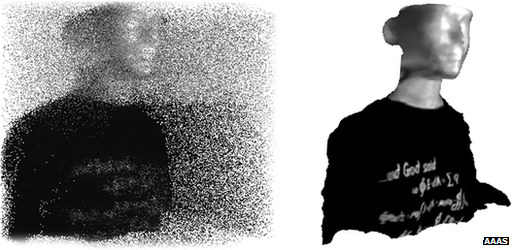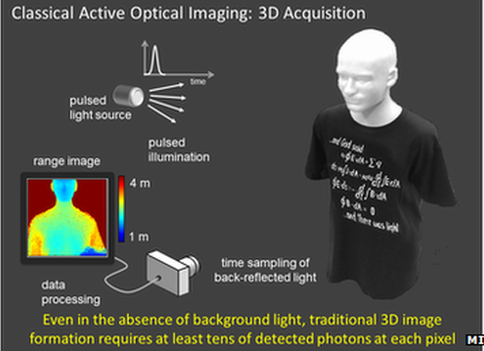Meanwhile... Researchers Develop A Camera That Takes Photos In The Dark
Anyone with a smartphone knows how impossible it is to take pictures in the dark. At best you get a picture that looks like a pile of dark to darker grains of sand. Researchers, however, have come up with a better way.
Scientists at MIT have made a camera that can take 3D pictures - in practically total darkness
The 'First-Photon Imager' camera developed by MIT researchers takes pictures in near total darkness by reconstructing 3D images from photons, or single particles of light that are reflected from an object.
dailymail.co.ukThe camera works by reconstructing 3D images from photons reflected from barely visible objects.
The technology could be used in next generation spy cameras or to treat eyes that are easily damaged by bright light.
The new camera technology, developed by Ahmed Kirmani of MIT, needs only one photon per pixel
Ordinarily, cameras shooting in low-light settings require tens or hundreds of photons per pixel to take a high resolution photo. Normal cameras taking photos in brighter settings need trillions of photons.
On the left is an image created using current technology - the photo on the right was produced from the MIT team's new camera technology
Image via bbcimg.co.uk"Our camera is a computational imager that works by repeatedly illuminating the scene with pulses of light, and by detecting the first photon arrival at each pixel," said Kirmani.
"The time-of-arrival data associated with the first photon detections is computationally processed using our new signal processing algorithms to form 3D and reflectivity images."
What's impressive is that the new 3D picture in the dark method doesn't even require new technology. It's just new math.
The new method uses a single particle of light to mathematically stitch every other piece of the photo together. It's nuts. One photon can turn what looks like haze to a much clearer picture.
The camera uses a process made up of multiple steps to remove noise from the laser scan made by detecting a single photon for each pixel. This process produces the final image, which is sharper than that created by rival technologies.
Image via dailymail.co.ukScientific American explains: "In the team's setup, low-intensity pulses of visible laser light scan an object of interest. The laser fires a pulse at a given location until a single reflected photon is recorded by a detector; each illuminated location corresponds to a pixel in the final image."
The laser and detector are not new; they're similar to the LIDAR system used by Google Street View
"We borrowed the principles form this, the detectors can identify single photons but they still need hundreds of thousands to form images. But we took the system to its limit," Electrical engineer Ahmed Kirmani of MIT explained.
Lidar uses a laser to fire pulses of light towards an object in a grid sequence. Each location on the grid corresponds to a pixel in the final image.
Lidar uses laser pulses and the team used the reflected photons to create their 3D image
Image via bbcimg.co.ukThe team say the technology could be used in many different fields. It could help ophthalmologists when they want to create an image of a patient's eye without having to shine a bright light in someone's eye.
dailymail.co.ukThe research was part funded by the US Defense Advanced Research Projects Agency which commissions research for the Department of Defense. Mr Kirmani said the military could use the technology to allow soldiers to see in the dark, giving them an advantage in combat situations.
Current 3D imaging techniques require more than single photons unlike the team's new system
Image via bbcimg.co.ukThe so-called First-Photon Imager camera may not be on the market any time soon; it seems likely to be used for intelligence or military purposes first. It could also help examine any kind of physical, chemical or biological specimens that would be destroyed in bright light.




